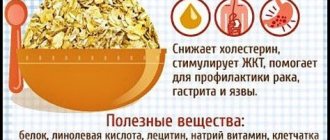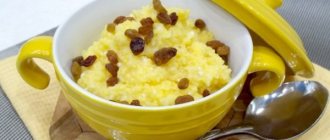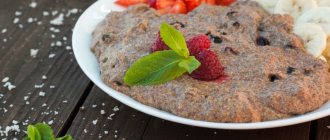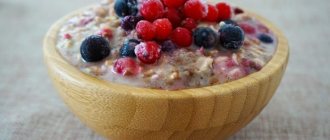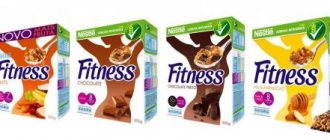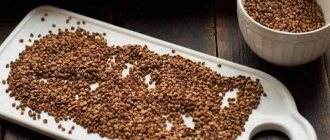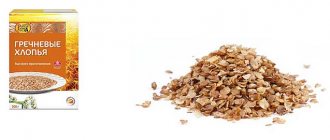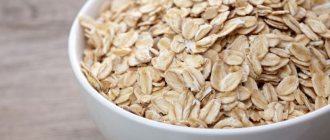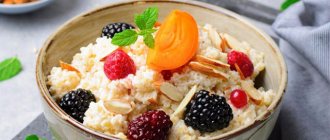The French prefer a croissant and coffee for breakfast, Americans get by with a glass of orange juice and a couple of toasted breads with jam, and the Germans love high-calorie sausages with a side dish. It’s hard to imagine residents of Great Britain without a morning bowl of oatmeal, and in this regard, our traditions are somewhat similar.
Porridge (semolina, millet, buckwheat and others) has been the main dish for breakfast since ancient times. It gives energy and strength for the day and has a positive effect on the body. Oatmeal is considered the recognized “queen”. You will find the benefits and harms, opinions of nutritionists and the most delicious recipes in our review.
Oatmeal works wonders
The benefits and harms of oatmeal – which outweighs? Anyone who has already included oatmeal in their diet only confirms the conclusions of experts. This amazing product has a positive effect on almost the entire human body:
- Antioxidants in oatmeal take care of the beauty of nails, hair and skin, and also give youth.
- Vitamin K, which has long been in the shadow of more well-known vitamins, improves blood clotting, normalizes kidney function and serves to prevent osteoporosis.
- Biotin improves overall well-being and strengthens the body.
- Oatmeal is indispensable for athletes who want to build muscle mass.
Regular consumption of oatmeal will help lower cholesterol levels, prevent blood clots and improve the condition of the cardiovascular system.
Benefits of oatmeal
The benefit of oatmeal does not lie in its low calorie content (we have already noted that oats have a calorie content quite typical for grain crops) or in the high content of microminerals (green buckwheat has even more of them). The positive effect of oatmeal on the human body is explained primarily by the beta-glucan it contains.
First of all, due to the mechanical absorption of liquid, this substance slows down the onset of hunger and creates long-term satiety. In addition, it acts as a prebiotic - food for beneficial bacteria living in the gastrointestinal tract. Research also suggests that beta-glucan normalizes blood sugar levels and helps reduce bad cholesterol¹.
Benefits of oatmeal:
- Has an average glycemic index
- Provides long lasting saturation
- Has prebiotic properties and improves immunity
- Normalizes blood sugar levels
- Helps reduce bad cholesterol levels
Oatmeal for breakfast - pros and cons
In order for oatmeal to have its positive effect on health, it must be consumed quite often - best of all, every day for breakfast. The health benefits of beta-glucan only appear if at least 3 g of this substance is consumed, which corresponds to 30-40 g of dry cereal³. In other words, one regular serving of oatmeal is enough.
The downside of oatmeal may be the presence of lactose and gluten in it. Lactose appears when you cook porridge with milk. Regarding gluten, it is not found in pure oat grains, but can be introduced into the oats during the milling process (often using the same equipment as for processing wheat). If oatmeal is gluten-free, it will usually say so on the package.
Allergy to oatmeal
An extremely small number of people have a food allergy to oat protein (Avegin) - most often we are talking about young children. In addition, oatmeal with fruit prepared in milk can provoke bloating - however, in this case it is more correct to talk about individual intolerance to the combination of ingredients, and not at all about a dangerous allergy.
Nothing extra
“Oatmeal: benefits and harm”, “oatmeal: calorie content”, “oatmeal for weight loss” - these are the most popular topics for discussion regarding the favorite dish of prim Englishmen.
You can achieve maximum benefit from a huge amount of nutrients and minimal calorie content by cooking oatmeal in water. This method will please your stomach and intestines the most.
Porridge coats the walls of the stomach in a special way and facilitates the digestion process. For the intestines, oatmeal does another important job - it is like a brush to remove accumulations of harmful formations.
Doctors especially recommend including oatmeal in the diet of patients with duodenal and gastric ulcers. In addition, one serving of porridge contains a quarter of the daily fiber requirement.
Oatmeal: health benefits and harms for adults and children
All pediatricians unanimously say that oatmeal is the best product for our kids. The only cereal that can compete with the cereal we are describing is buckwheat.
- Oatmeal contains a lot of protein, phosphorus and calcium, which is a building material for a child’s body.
- The relationship between iron and group B vitamins stimulates hematopoiesis in a child and is an excellent remedy for anemia.
- Protein metabolism is ensured by vitamin N, and oatmeal grains are champions in the content of healthy fats.
It is also clear from the above that the product reduces bad cholesterol, improves the child’s mental and intellectual abilities, improves immunity, restores the nervous system, protects against constipation, etc. The product contains many substances that give vigor and energy, and dietary fiber will not allow the development of obesity.
Regular consumption of porridge will eliminate skin inflammation, improve the condition of hair and nails, enhance muscle growth and forget about allergies and skin dermatitis. The nutritional value of porridges and soups will satiate the body for a long time and not feel hungry for a long time.
At what age can you feed your baby oatmeal? Pediatricians give a precise answer to this question - you can start at 8 months of age. The main thing is that complementary foods are not thick and match the consistency of baby food. But this only applies to children with natural lactation. With artificial feeding, you need to start at 10 months of age. If a child has a tendency to diathesis, postpone the consumption of oatmeal until a later age - 2-3 years.
Water oatmeal recipe
It takes very little time to prepare morning porridge. Some of us prefer to use a multicooker, with which all the necessary ingredients can be loaded in the evening, and in the morning the aromatic dish will be ready at the appointed time. But even without such a smart device, a novice “cook” can do it in no time.
- Bring two glasses of water to a boil.
- Add three quarters of a glass of oatmeal and cook over low heat. In terms of time, we focus on the manufacturer’s recommendations.
- If desired, add salt and a few tablespoons of butter.
- You can improve the taste of oatmeal with a small amount of honey, nuts, candied fruits, or frozen and fresh berries.
For those who are used to drinking only coffee in the morning, such a breakfast may seem too filling. But once you try it, you will notice the boost of cheerfulness and good mood that oatmeal gives. The benefits and harms of this simple recipe do not require additional comments, because even with water, porridge can be very tasty.
History of oatmeal
According to the chronicles, the first mentions of the product are reflected in Ancient Greece and Rome.
But the cereal was used not as a food product, but as feed for livestock. By the 13th century, they had just begun to prepare dishes from oats to make soup. Residents of Scandinavia, Rome, Greece and European countries, ancient Rus' used it as a supplement to meat and fish, as well as seafood and mushrooms. Regular consumption of the product gave lightness, freed the body from excesses and gave vigor. In the 16th century, the liquid soup turned out to be a nourishing and pleasant-tasting porridge. It was only in the 19th century that milk was added to ready-made oatmeal, and the excellent taste pleasantly surprised ordinary people. Then innovation came and steam-processed flakes were created.
https://www.youtube.com/watch?v=g-zKgHpHlOA
Many people wonder how oatmeal differs from rolled oats or whether they are the same product. The difference lies in the manufacturing technology. Hercules or oat flakes are prepared using the following technology - the grains are cleaned, passed through strong steam and pressed with rollers until a flattened shape is obtained.
With milk
Another cooking option is with milk. Many people will like this oatmeal. The calorie content, benefits and harms of milk oatmeal cause a lot of controversy. Nutritionists say that this breakfast is most suitable for small children and athletes. These two categories are united by one goal - to gain weight.
In other cases, it is better to avoid eating porridge with milk. As a compromise, you can significantly dilute the milk with water and omit the butter and sugar. Then the declared calorie content (100 grams contains more than 110 kcal) will be slightly reduced.
It is worth noting that even milk porridge for breakfast will be much healthier than a sausage sandwich or strong coffee. Therefore, those who are not worried about their figure can eat as much oatmeal with butter as they want.
Oatmeal: health benefits and harms for adults and children
Oatmeal is beneficial to the body, but you should not make it the basis of your diet. When consuming the product in large quantities and for a long time, the absorption of vitamin D and calcium is impaired. It is caused by the accumulation of phytic acid. This leads to weakening of the skeletal system.
The main contraindication is gluten intolerance (celiac disease). But also do not forget that instant oatmeal without cooking and flavored dishes from bags do not provide any benefit and can cause allergies, indigestion, and thereby cause harm to the body.
Baby food
The World Health Organization recommends that new mothers maintain breastfeeding for as long as possible. But babies often have problems with nutrition, and as a result, constipation, colic and bloating appear. If the child’s age is already ready for complementary feeding, then pediatricians advise starting with buckwheat or oatmeal.
Ten years ago, the main porridge for children was semolina, but today its benefits are questioned. Frequent consumption of semolina by babies under one year old can lead to serious intestinal diseases, so it’s not worth the risk.
The benefits and harms of oatmeal for the body of an infant are also of concern to every mother, but after reading the opinions of experts, you can easily make the right decision. Modern baby food manufacturers offer instant dry cereals. The choice is really great, and at first you can use ready-made products. However, as your baby gets older, it is better to switch to regular oatmeal.
Depending on the desired consistency, you can use a coffee grinder to grind them into flour or a little coarser. Thus, a healthy breakfast will appear in the child’s diet, which will also train chewing skills.
How to cook oatmeal?
To cook oatmeal, you will need 4 to 5 parts liquid to 1 part flakes, depending on the desired thickness and type of grinding. For a standard serving of cereal (50 g), you usually take 200-250 ml of water or milk. First, the liquid is brought to a boil, then the flakes are poured into it. The heat is reduced to a minimum, after which the oatmeal is cooked for 5 to 15 minutes.
After the cooking process is complete, you can add butter, sugar, jam or even fresh fruit to the finished oatmeal. In this case, their taste will be preserved as much as possible. The ideal choice would be a finely chopped banana with a pinch of cinnamon. For those who have a sweet tooth, we recommend that you give up regular white sugar and use a natural sweetener based on stevia.
Oatmeal with water:
- 1 part flakes
- 4-5 parts water
- 5-15 minutes of cooking
Cereals “Hercules”
Hercules is the name for coarsely ground oatmeal, adopted in the Soviet Union. Hercules flakes contain more fiber (essentially the shell of the grain) and require more cooking time - about 20 minutes. At the same time, most modern types of oatmeal undergo pre-treatment (both mechanical and thermal), which reduces cooking time.
Oatmeal jelly
To prepare jelly from oatmeal, you can use both finely ground flakes and crushed oat grains. The second key ingredient will be kefir - thanks to the presence of lactic acid bacteria, it will ensure the fermentation process. The ingredients are mixed in a glass jar, after which it is placed in a dark and warm place for 2-3 days for fermentation.
At the end of the fermentation process, the liquid (oatmeal jelly concentrate) is filtered from the flakes and poured into a separate container. The concentrate must be left for approximately 18 hours to separate into fractions. The transparent upper fraction is oat kvass. The white and dense lower fraction is the basis for oatmeal jelly. The jelly itself is boiled in water with the addition of butter and honey.
Ingredients (for 2 liters of drink):
- 200 g chopped oat flakes
- 6-7 tablespoons of Hercules flakes without crushing
- 4 tablespoons kefir
- 1.3 liters of water (boiled, cooled)
***
New Fitseven materials, 5 times a week - in telegram:
- fit7seven
Regular consumption of 30-40 g of oatmeal for breakfast is good for health. Oatmeal not only helps normalize blood sugar levels and reduce bad cholesterol, but also improves the body's immunity due to the prebiotic properties of oatmeal - that is, a positive effect on the growth of the population of beneficial intestinal bacteria.
Problems start in childhood
It is impossible to answer the question of what are the benefits and harms of oatmeal. How to choose without full information about the danger that awaits oatmeal lovers? Let's talk about celiac disease.
Few of us know about a similar disease, in which eating the famous British dish is contraindicated. Celiac disease, or celiac disease, is inherited.
Substances hordein, gluten, avenin in cereals (oats, wheat, barley) disrupt the digestion process, damaging the villi of the small intestine. As a result, intestinal absorption is impaired, which, in turn, leads to malnutrition and the manifestation of rickets-like syndrome. Unfortunately, the consequence of such a failure is food allergies, polyhypovitaminosis and other health problems. Obviously, the benefit of oatmeal for breakfast for the intestines of a patient with celiac enteropathy is reduced to zero.
Most often, celiac disease is diagnosed in infants. After introducing porridge into your baby’s diet, it is very important to monitor changes in stool. Weight loss, an enlarged tummy and frequent, loose, grayish stools should be an alarming signal for parents. Without proper treatment and monitoring, the child may lag behind in psychomotor development.
Contraindications and harm from use
Not everyone knows what is harmful about oatmeal. But this porridge is not always useful, especially if you use it too often. So, what harm can this porridge cause:
- if you abuse this cereal, it can result in the leaching of calcium and vitamin D from the bones. In the future, this can lead to the development of osteoporosis and changes in bone tissue;
- If you have celiac disease, you should not eat this food. Those with a history of such a diagnosis should refuse this porridge, because they are susceptible to toxic effects on the mucous membrane of the small intestine. In the future this will result in malnutrition;
- This cereal is also undesirable for stomach bleeding or erosions.
In fact, everything depends only on the individual characteristics of the body.
Oatmeal, sir!
The benefits and harms of oatmeal for breakfast are directly related to the type of cereal. The most correct and longest cooking method requires purchasing whole or crushed oat grains.
If you choose this option, then be sure to use the original Scottish recipe. Oatmeal, or porridge, is beloved by residents of this part of the UK. Traditionally, porridge is prepared without adding salt, milk, butter or sugar, so that the additional ingredients do not overpower the original taste.
The grains are poured into boiling water and cooked over low heat, stirring constantly, for about half an hour. As a result, oatmeal acquires an unusual nutty aroma, which the Scots are so afraid of missing out on. While eating, you can add salt to the porridge.
Traditionally, the dish is cooked for the whole week at once. The finished oatmeal is cooled, cut into portions and consumed as needed. For residents of Great Britain, it is very important to observe centuries-old rituals, so they are not particularly concerned about the benefits and harms of oatmeal.
What types of cereals are suitable
In case of exacerbation of gastritis, prepare porridge only in water. When a person feels better, it is allowed to cook porridge with milk.
Prepare whole grain porridge as follows:
- Rinse a glass of oats and fill with water. Leave overnight.
- In the morning, rinse the cereal again and add 1.5 liters of water.
- Cook for an hour, stirring frequently.
- At the end, add a little butter to the porridge.
Oatmeal is prepared as follows:
- boil 4 cups of water;
- pour a glass of cereal into the water;
- cook until tender, stirring constantly.
Why is this oatmeal, a cereal familiar to all of us, so beneficial for human health? Doctors say it’s all about balanced composition and saturation. So, let's look at some properties of oatmeal.
- Antioxidants - the element is a powerful substance that actively fights cancer. It has a negative effect on free radicals and prevents the formation of carcinogenic particles. Antioxidants also help stimulate blood flow, which improves brain nutrition and activates memory, mental functions, hearing and vision.
- The content of a large amount of iron regulates the level of red cells in the blood - erythrocytes. The substance is also involved in hematopoiesis, which is very useful for anemia and anemia.
- Calcium and the microelement phosphorus strengthen the human skeleton, prevent the development of osteoporosis, perforation of vessel walls, which has a positive effect on the functioning of the cardiovascular system, the condition of nails, hair and skin.
- Oatmeal is a champion in containing a unique element - zinc, which incredibly effectively supports the immune system. Also, the substance is the best that can be for improving metabolism, blood quality and protection against infectious diseases. Together with the element calcium, the substance participates in strengthening the bone structure and forms the correct structure of teeth in both adults and children. With zinc deficiency, a malfunction of the cerebral cortex occurs. Because of this, epilepsy, impaired mental function and disability are possible.
- The sodium contained in oatmeal regulates water and salt metabolism in the body and promotes the effective interaction of important elements.
- The presence of magnesium ensures normal functioning of the nervous system, helps concentrate attention and clear memory. Also, regular consumption of porridge helps to increase intellectual abilities.
- The presence of potassium improves the functioning of the cardiovascular system and helps keep blood vessels elastic and firm.
- The cereal contains beta-glucan - a unique substance that reduces the level of bad cholesterol, removes decay products of dead cells, pathogens, toxins and waste from the body.
It is difficult to accustom a baby to oatmeal, or any other porridge. We offer cooking methods that no child will be able to turn up their nose at.
Oatmeal jelly
To prepare we need:
- a glass of cereal (extra);
- a piece of bread (black);
- half a liter of water;
- a pinch of salt.
Pour water over the flakes and leave for 12 hours. Then add bread and leave for another 2 hours. Remove the bread from the liquid, grind the pulp through a sieve, cook over low heat for another 10 tons. Stir constantly. Then cool and serve cold. If you add milk, the dish will be more satisfying.
Light oat soup
To prepare a delicious and easy soup we will need:
- liter of water;
- 1 carrot;
- 1 onion;
- 100 grams of flakes;
- 2 potatoes;
- 50 grams of butter;
- pepper, herbs and salt to taste.
Wash and clean the vegetables thoroughly. We also thoroughly wash the greens under running water. Dice vegetables, finely chop greens. You can use either water or vegetable or meat broth. The liquid should boil, add vegetables and salt, pepper and cook for 10 minutes. Add oatmeal and boil for another 10 tons. When serving, add herbs.
Longevity Drink
To prepare we will need:
- a glass of cereal;
- 1 liter of water.
Rinse the oatmeal thoroughly and pour boiling water over it, put it on the fire and boil. As soon as it starts to boil, remove from the heat and leave for 60 t. Then strain the mixture and drink for 2 weeks three times a day, half a glass half an hour before meals. The course is repeated 3 times a year. The effect will be enhanced if you add a couple of spoons of honey and a few drops of lemon juice to the drink.
Before consuming oatmeal for stomach ulcers and gastritis, you need to choose it correctly. Despite the fact that cereal is available in many hypermarkets, only certain types are suitable for the treatment of gastritis and gastric ulcers.
For a diet for gastritis, preference should be given to only two types of oatmeal:
- whole grain cereal. This type is usually preferred by many housewives, as well as people who have diseases of the stomach and duodenum. It is recommended to cook oat grains for at least two hours. But at the same time, this type of cereal is considered the most useful;
- unprocessed flakes. Cereals are produced in boxes indicating the method of preparation and cooking time. If cereals are purchased for therapeutic nutrition for gastritis, then preference should be given to porridge, which is prepared in at least 15 tons.
How to choose oatmeal?
In the modern world, time is valued even more than money. Many of us do everything on the go, including breakfast. To prepare yourself the right oatmeal you need at least 20-30 minutes, which sometimes there is simply nowhere to get it. However, there is an easy way to organize a healthy breakfast in a matter of minutes - instant porridge. Let's figure out what this oatmeal is.
Benefits and harms, beneficial properties, composition, preparation time - these are the main points that we will focus on.
“Quick” porridges can be divided into two types according to the duration of preparation: instant readiness and the need to cook for several minutes.
The first option dissolves in a plate in a matter of seconds. You pour out the contents of the bag, pour in hot milk (less often water) - and a hearty breakfast is on your table. But how many nutrients are lost during the cereal production process? Answer: almost everything.
At the first stage, the husks are separated from the grains, and at the second, they are crushed. The less time you need to cook the porridge, the finer the flakes. Such a product instantly absorbs liquid, and our body absorbs the starch inside it at an incredible speed. In addition, information about additives in the form of fruits, nuts or honey once again confirms the harm, because we are talking about flavorings and flavor concentrates. Regular consumption of the wrong oatmeal can lead to serious consequences: from weight gain to diabetes or cardiovascular disease. Such oatmeal, the benefits and harms of which are so obvious, should not appear in the diet of adults and children.
Oatmeal during pregnancy and breastfeeding
The chemical composition of oatmeal allows it to be consumed without any restrictions during preparation for childbirth and during lactation. It helps improve immunity and cleanse the blood. During pregnancy, a woman who consumes this porridge will be able to get rid of symptoms of toxicosis, drowsiness and improve her mood. Oatmeal helps relieve heartburn and prevent flatulence and bloating, which often occur during pregnancy. Doctors are confident that with regular consumption of oatmeal, women endure pregnancy much easier and do not suffer from stomach problems.
Instant porridge
The beneficial and harmful properties of instant oatmeal are the subject of constant debate. The processing process is very similar to what we described earlier for instant porridges. The difference is in the degree of grinding of the flakes, and this affects the cooking time.
Nutritionists have concluded that the presence of minerals in instant cereals outweighs the harm from starch. Therefore, you can still afford such a breakfast several times a week. Choose unflavored instant oatmeal - it's best to add pieces of fruit or nuts before eating.
It turns out that the healthiest oatmeal cereals are those that are packaged in large, nondescript boxes. They do not need additional advertising or colorful packaging. As a rule, the cooking time for such oatmeal is from 10 to 20 minutes.
Chemical composition of oatmeal
The beneficial qualities of oatmeal directly come from its rich composition. It is impossible to list every single element; we will indicate the substances that are most known to us. The composition of oatmeal includes: proteins, carbohydrates, ash and fats.
As for carbohydrates, both glucose and sucrose and starch are present here.
The list of proteins is also amazing; the cereal contains acids: isoleucine, histidine, lysine, valine, methionine, glutathreonine, phenialalin, tryptophan.
The list also contains replaceable types of acids: serine, alanine, proline, arginine, glycine, asparagine, cystine, tyrosine.
Oatmeal contains saturated and polyunsaturated, monounsaturated fats.
The central series is represented by: manganese, calcium, copper, iron, zinc, magnesium, sodium, phosphorus, etc.
The twisted series is rich in: tocopherol (E), ascorbic acid (C), retinol (A), thia (B1), Choline (B4), Riboflavin (B2), Folacin - folic acid (B9), Niacin (B3 or PP), pyridoxine (B6), pantonene (B5), etc.
Oatmeal diet
In pursuit of a beautiful figure, representatives of the fair sex are ready to make sacrifices. Unfortunately, few people prioritize physical activity and proper nutrition.
It’s easier to stay on a diet for a couple of weeks than to completely rebuild your lifestyle. Such experiments very often end badly for health, and even such a healthy product as oatmeal can cause irreparable harm. But first things first.
A two-week oatmeal diet consists of eating porridge several times a day - this way you maintain a feeling of fullness. Many believe that since oatmeal, the benefits and harms of which have long been proven, is rich in all kinds of microelements, then it can be consumed in any quantity.
Oatmeal - what is it?
Oatmeal is one of the healthiest foods. Its benefits were known in ancient times (oats have been grown by mankind for more than one and a half thousand years) - and are confirmed by modern research. Oatmeal is recommended both for people who want to lose weight and for athletes training to gain muscle mass.
One of the key benefits of oatmeal is its high content of a unique type of fiber. About 2-8% of the dry weight of oats is the substance beta-glucan - a complex polysaccharide that has the ability to absorb liquid. Note that this substance has nothing to do with gluten - pure oatmeal does not contain gluten.
It is the presence of beta-glucan that gives oatmeal its characteristic viscous structure and makes it possible to prepare many tasty and healthy products from oats - including jelly and oatmeal, popular among followers of a healthy lifestyle. Oatmeal itself is loved because it is extremely easy to prepare. You can cook oatmeal in water or milk in just a few minutes.
Oatmeal - composition and KBJU
Since oats are a cereal crop, oat flakes differ little from other cereals in terms of the number of calories and nutrient composition. The calorie content of dry oatmeal is 370-390 kcal per 100 g (the figure always varies depending on the specific plant), the total carbohydrate content is 66-70 g (of which about 10-11 g is fiber), 17-19 g of proteins and 6-7 g fat.
The key vitamins in oats are thiamine (100 g of dry oats provides 51% of the daily value), folate (14%), pantothenic acid (13%), riboflavin (8%), vitamin B6 (6%) and niacin (5%). ). Key microminerals include manganese (246% DV), phosphorus (55%), magnesium (44%), copper (31%), zinc (26%), iron (26%), potassium (12%) and calcium (5 %).
